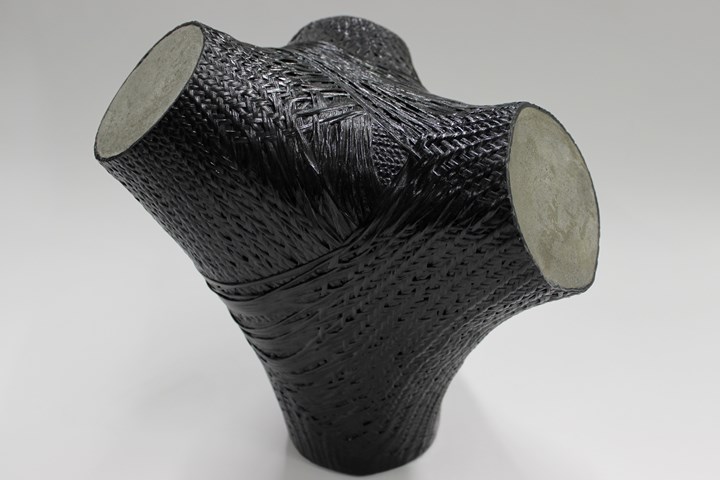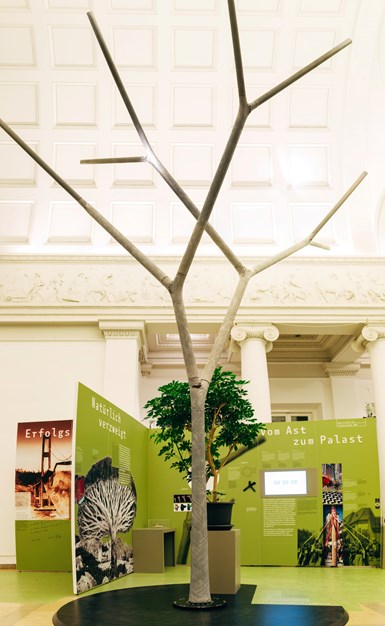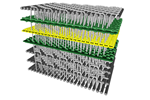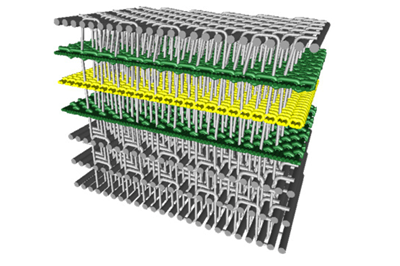Biomimicry braiding for load-bearing slender FRP node structures
An interdisciplinary research team has developed a spatially branched, carbon fiber-reinforced, high load-bearing supporting node for consideration in building and construction.

Concrete support node with carbon fiber-reinforced plastic hull. Photo Credit: Larissa Born, University of Stuttgart (ITFT), Institute for Textile and Fiber Technologies
An interdisciplinary research team from the University of Stuttgart (ITKE, ICD and ITFT) and the (DITF, Denkendorf) has developed a spatially branched, braided, carbon fiber-reinforced, high load-bearing supporting node as well as a process for manufacturing such complex structures. The biomimicry-inspired fiber-reinforced plastic (FRP) research and development is being carried out within the DFG-funded TRR-141 “Biological Design and Integrated Structures” in cooperation with the University of Freiburg (Germany).
“Weight is hardly a consideration in building and construction” according to Adriaan Beukers and Ed van Hinte, authors of “Designing Lightness” (2020). “Heaviness happens to be a traditional quality that comes with a gut feeling of trustworthiness and pride.” With an estimated 41% of global energy consumption attributed to buildings and structures according to the Energy and Environmental Building Alliance (EEBA, Plymouth, Minn., U.S.), there is a growing movement towards materials that can lighten the impact in every sense. Fibers, textiles and composites in particular are said to be growing in importance for the sector with a projected growth from $45 billion in 2017 to an expansion of more than 4.5% CAGR by 2025 (Global Markets Insights).
Moreover, according to , an industry consultant, visiting professor at the Royal College of Art (RCA, London, U.K.), public and private buildings with open, wide and light spaces have an identified need for a supporting structures with branched columns to minimize the number required and the ground space they occupy. Similarly, in bridge construction, slender-branched load-bearing elements enables aesthetically pleasing and resource-saving constructions that perform very effectively in load distribution. The technical challenge of branched load-bearing structures is the connecting component, or structural node, between the straight members which is subjected to complex forces.

Branched, braided supporting structure consisting of node elements and straight supports. Exhibited at Natural History Museum, in Stuttgart. Photo Credit: University of Stuttgart (ITKE), Institute of Building Structures and Structural Design
In this project, high-strength carbon fibers, used in synergy with concrete, are precisely aligned and arranged in order to maximize their mechanical properties. According to the research team, concrete is good at transferring the compressive forces that occur, while the outer FRP hull absorbs the tensile or bending stresses of the load-bearing nodes.
The fiber preform is produced using a braiding process. With the radial braiding machine used, up to 216 threads are braided simultaneously to produce a 3D textile with three fiber directions. The braiding threads inserted in the circumferential direction of the core geometry primarily form the dense cover for the concrete casting. Acting as a confining agent, the fibers force a multi-axial stress state, increasing the compressive strength of the concrete. The filler threads oriented in the axial direction mainly dissipate the tensile forces occurring during bending loads. The textile preform is then impregnated with a thermosetting polymer and consolidated into the solid FRP hull. Researchers found that the structure is dimensionally stable and can be used as a casting mold into which the concrete filling is poured.
One of the key challenges addressed by the team has been the development of a digitized workflow to reduce the time taken in setting up the process, such as the time-consuming process of programming the mandrel path through the braiding machine and the fiber placement, which is also a barrier to commercialization. With the development tool, the research team notes that it is possible to define the mandrel path through the braiding machine in a virtual braiding environment location, enabling considerable setup time to be saved. In this way, large and geometrically complex structures such as branched, 3D components can be produced with a continuous fiber reinforcement.
Moreover, the principles of biomimicry have been used to analyze the plant-branching effect for efficient load transfer, orientating the high-strength carbon fibers and developing the manufacturing process for the load-bearing node. Because the difference in the manufacturing effort for changing the geometric configurations of the node geometry is so slight, the process offers the architect, engineer or designer great freedom of design at a relatively low cost in time and money.
While already offering many possibilities, this biomimicry-inspired composite looks set to inspire whole new structure in the future. The four-arm node will be exhibited during JEC World 2022 from May 3-5 at the Innovation Planet “Building & Industry.”
Related Content
Plant tour: Airbus, Illescas, Spain
Airbus’ Illescas facility, featuring highly automated composites processes for the A350 lower wing cover and one-piece Section 19 fuselage barrels, works toward production ramp-ups and next-generation aircraft.
Read MoreWelding is not bonding
Discussion of the issues in our understanding of thermoplastic composite welded structures and certification of the latest materials and welding technologies for future airframes.
Read MorePlant tour: Teijin Carbon America Inc., Greenwood, S.C., U.S.
In 2018, Teijin broke ground on a facility that is reportedly the largest capacity carbon fiber line currently in existence. The line has been fully functional for nearly two years and has plenty of room for expansion.
Read MoreCarbon fiber, bionic design achieve peak performance in race-ready production vehicle
Porsche worked with Action Composites to design and manufacture an innovative carbon fiber safety cage option to lightweight one of its series race vehicles, built in a one-shot compression molding process.
Read MoreRead Next
Smart, self-powering composite from DITF uses a "textile power plant" concept
Multilayer fabric-based piezoelectric elements and pyroelectric energy harvesters reinforce the FRP structure, generating electrical energy using vibration, oscillation and temperature fluctuation.
Read MoreNext-gen fan blades: Hybrid twin RTM, printed sensors, laser shock disassembly
MORPHO project demonstrates blade with 20% faster RTM cure cycle, uses AI-based monitoring for improved maintenance/life cycle management and proves laser shock disassembly for recycling.
Read MoreCutting 100 pounds, certification time for the X-59 nose cone
Swift Engineering used HyperX software to remove 100 pounds from 38-foot graphite/epoxy cored nose cone for X-59 supersonic aircraft.
Read More












